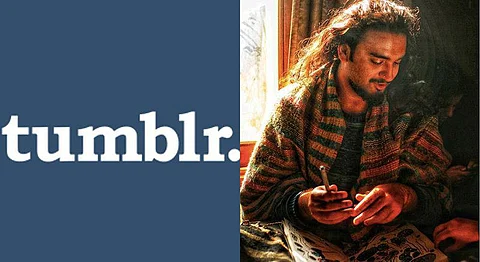
- HOMEGROWN WORLD
- #HGCREATORS
- #HGEXPLORE
- #HGVOICES
- #HGSHOP
- CAREERS
- ABOUT US
- CONTACT US

For many years since its inception up until this moment, Tumblr reigned as a space in the internet for the weird, wonderful as well as the responsible adult. From those pedalling porn-GIFs to erotic art, from steamy home videos to smutty fanfictions, people flocked by the millions to explore the recesses of the site, cushioned by anonymity and embraced by a relatively judgement-free space that not many social media sites offered. Data scientists estimate around 30 million active accounts consuming content of this nature.
But all of this seems to have changed with Tumblr’s new censorship laws on adult content, which ban any “images, videos, or GIFs that show real-life human genitals or female-presenting nipples” along with work that depict the sexual act. While there are various speculations on the exact reason initiating this change, it caused a considerable stir among Tumblr’s loyal users including consumers of adult content on the site, but also specifically, the NSFW artistic community.
Tumblr grew as a space for artists who bogged down by censorship laws of other social media forums, could display their art freely and unfiltered. Artist Aditya Verma, whose work on body art was specifically meant to be digitally published tells us “Tumblr always projected itself as a safe space, it’s not going to fall into politics and the idea was that it was a space where I knew I could post something and and nothing is going to change it. The entire communication of this idea, the language they used, the branding, the marketing, all of it aligned with the idea of Tumblr being such a platform.” Verma who has had unpleasant experiences with censorship on his Instagram account, viewed Tumblr as a worry-free space for his art, for his audience to freely engage with his work without judgement or stigma.
But for some others, Tumblr came with its own issues way before the recent censorship laws. Pulkit Mogha, a photographer popularly known for his work capturing intimate moments between people of all gender and sexual identities, initially started out with similar notions of how Tumblr was a safe space for all kinds of artists to thrive. However, when social networking website marked his Tumblr account as one having adult content, he was quite disappointed as it reduced the visibility of his work. People could now only view his work if they had logged in so the exposure he was getting from the site became negligible. Hence, he decided to move off the site much before the ban. Despite this, he believes the internet has lost an important space, and comments “Tumblr is one of those spaces where you had no external bodies, no capitalist motives, no companies- just independent creators, just people talking to people and sharing their own content. There isn’t an avenue like that anymore.”
Though the ban may have been initiated because of the discovery of child pornography on its site, many believe that the shift of ownership of the site to Verizon has a lot more to do with it, owing to the company’s more conservative policies. Besides, the artificial intelligence driven ban has hilariously exploded upon Tumblr’s pages with no apparent plan of action, and has erroneously flagged random things, including and not limited to drawings of purses and chocolate ghosts (do yourself a favour and look up #tumblrisdeadparty for more examples).
Setting aside the cause, the consequences fall on the marginalised communities. Tumblr was a safe space for groups like women and queer youth sexually and artistically. While the site’s policies say they will allow certain artistic or political nudity, the censorship patterns are rooted in socio-political biases. Mogha believes that the general trajectory with social media policies seems very regressive, especially for gender, sexual, and racial minorities. “We have to constantly fight for agency, they tell us that our content does not fit their ideas of art and aesthetics. But are our bodies not art? Brown bodies suddenly have to fight twice as hard to be seen but there are so many accounts of these flawless muscular white bodies which are easily seen as art,” He says. Overall, it is definitely a loss in terms of visibility, agency and representation of marginalised groups.
Another consequence is the effect on the artist’s avenue for growth, and accessibility of art in general. For Verma, Tumblr was a space that at no cost, served as a platform to showcase his work without external control. “When I heard of the ban, I was genuinely just so tired of finding a safe space for my work. Already having a tumultuous relationship with forums like Instagram constantly shadow-banning and flagging my art, I don’t really know how my work will survive. I’ll probably have to pay for a website, something which is not too feasible for many working artists.” Without direct audience engagement and participation, there is a lack of organic growth for the artist’s visibility in the industry.
Both Mogha and Verma believe that in the life-cycle of the nature of social media platforms, such a trajectory was inevitable and that going forward NSFW content will find loopholes and continue to exist on the fringes. But for artists like them, who are trying to visibilise certain healthy discourses on sexuality and nudity, it is an apparent drawback. Like many others, they too believe that Tumblr has lost its inherent essence along with a huge user base, and could possibly cease to exist.
Feature Image Courtesy of Aditya Verma Instagram and Iconarchive.com
If you liked reading this article, we suggest you read:
